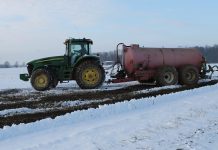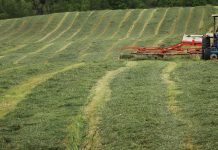Squeeze almost any official of almost any agbiz or farm group and the words “Feed the world” will cross their lips. The phrase is this century’s “Manifest Destiny,” a near-imperative, a cornerstone of our export-directed ag policy.
But this ambition, according to the number-crunching crew in Daryll Ray’s ag shop at the University of Tennessee, has been more of a mission statement than a mission accomplished.
Big five grains
Writing in an early April “Policy Pennings” column, Ray notes that the combined 2010/11 U.S. exports for barley, corn, oats, rice and wheat “at 88.0 million tonnes (is) 82.4 percent of the 106.8 million tonnes of grain exports in the 1980/81 crop year.”
That’s right; we’re exporting 18 percent less of the Big Five grains today than 30 years ago.
When soybeans are added to the export numbers, Ray notes, 1980/81 sales of the six rise to “126.5 million tonnes (while) 2010-11 projected exports are 131.3 million tonnes.”
Soybeans
So, U.S. exports of the Big Five and soy did increase over 30 years but only by “3.8 percent from the beginning to the end of the 30-year period,” says Ray.
That small achievement pales when compared to the rapid growth of the global market for the Big Five over the same 30 years — from “196.6 million tonnes to 261.3 million tonnes, an increase of 37.6 percent,” Ray reports.
Viewed another way that means “the U.S. [share of this market] dropped from its 1980/81 peak of 54.3 percent to 33.7 percent,” he writes.
Again, if U.S. soy exports are added, then “the U.S. share of world exports of soybeans and the five grains declined from 58.1 percent in 1980/81 to 36.5 percent in 2010/11.”
Wow
Thirty years and five export-directed farm bills and still the “numbers indicate,” writes Ray, that American farmers serve the world in the “much more modest role of residual supplier” than global grocer.
This worldly focus, however, has food and nutrition consequences at home, suggests Angie Tagtow, an Iowa-based registered dietitian and public health researcher.
For example, she notes, the 1978 U.S. Ag Census showed 50 percent of all Iowa farms grew hogs, 60 percent grew cattle, 56 percent grew hay and 34 percent grew oats. The 2002 Census showed these segments, respectfully, at 12, 33, 36 and 8 percent.
Healthy food
Taken across the nation, Tagtow explains, the 30-year shift to commodities means “We’re not growing enough ‘healthy’ food to meet minimum federal guidelines for a healthy diet.”
She’s right
According to data compiled by the USDA’s Economic Research Service in 2007, if every American followed USDA’s dietary guidelines every day, the U.S. would need 7.6 million acres more fruit production, 6.5 million acres more vegetable production and 11 billion pounds more milk than produced domestically.
We have enough, however, only — ironically — because of soaring imports.
According to USDA, the value of vegetable imports to the U.S. doubled from $3.4 billion in 1998 to $7 billion in 2007. Simultaneously, the value of fruit and nut imports nearly tripled, from $5.5 billion to $14 billion.
“We’re so focused on commodities,” says Tagtow, “that we’re increasingly relying on other countries to provide us with food.”
Balance
Searching for a balance, Tagtow and fellow dietitian Susan Roberts examined what this food policy means for Iowa, a state of agricultural bounty but not agricultural diversity. Their discoveries are detailed in “Cultivating Resilience,” a 56-page, Feb. 2011 report outlining the state’s food strengths and weaknesses.
For example, while only 0.04 percent of all Iowa farmland grows fruits and vegetables, 85 percent of the nearly $9 billion spent annually on food in Iowa leaves the state. (Links to “Cultivating Resilience” and Daryll Ray’s “Policy Pennings” are posted at www.farmandfoodfile.com.)
Facts like that suggest there might be a better future feeding America rather than feeding the world. Right now, we’re doing neither.














I wonder how much of that drop in US exports is connected to the preponderance of genetically modified seeds used to grow corn and soy in the US. Other countries don’t want that crap so it forced on US grocers by the Monsanto-run White House.